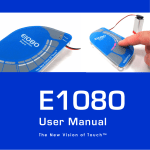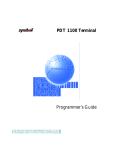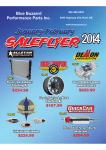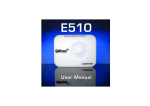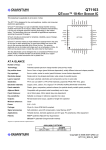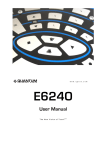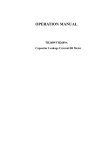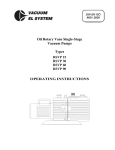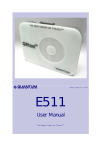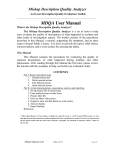Download User Manual - Digi-Key
Transcript
13 E240 User Manual The New Vision of Touch™ E240 16 User Manual OVERVIEW The E240 is designed to let you evaluate and develop with the QT240 4 key QTouch™ IC. It includes four independent touch sensitive electrodes with corresponding LEDs to indicate touch. Connections are provided for external interfacing. The E240 is powered from an external 7V to 12V DC source (such as a common 9V battery). For more detailed information about this product please refer to the latest QT240 datasheet at www.qprox.com/datasheets. Materials Provided: 1 x Clear plastic panel 1 x E240 self-adhesive eval board with battery clip 1 x 9V battery 4 x Rubber feet 2 x Sample QT240-ISS chips 1 x QRG product CD-ROM (with QT240 datasheet but check website for latest) 1 x User guide BOARD MOUNTING The E240 can be adhered to plastic, glass, or any other dielectric panel with its peel-back adhesive strip. You do not have to use the supplied panel if you would rather stick it on your own panel. Here’s how to mount it: 1 Place the plastic panel face down on a table; tape down the edges of the panel to the table so it cannot move. 2 Remove the peel-back paper from the E240 PCB and adhere the E240 to the back of the panel. Flex the E240 slightly while pressing down lightly on it to help eliminate trapped air. Take care to flex the board only slightly to prevent the delicate SMT parts on the board from cracking and failing. Tip: Line up the PCB with the alignment marks on the back of the slider panel. The PCB must be positioned as shown below so that the keys line up with the graphics. 3 Un-tape the board from the table, and mount the four rubber feet as shown above to make the E240 mechanically stable in use. 1 RUNNING THE E240 2 To run the E240, simply: 1 Place the E240 on a table, touch side up. 2 Connect the 9V battery while making sure your fingers are clear of the touch areas to allow proper no-signal calibration. The E240 is now ready to use! Touch the keys to see the LEDs light up. A continuous touch of 10 seconds will cause the key to recalibrate. Releasing the key after such an event and waiting a few seconds will cause the key to recalibrate yet again, and the key will function normally thereafter. THEORY OF OPERATION The E240 scans the keys using bursts of charge-transfer pulses. Immediately after power up, the signals from these bursts are used to calibrate the baseline reference values of the keys. This makes the device highly adaptive to mechanical differences (i.e. varying panel thicknesses). The QT240 chip also performs drift compensation on a continuous basis, so that the signals are constantly being adjusted at a slow rate to accommodate drift. The calibration process (done at power-up) should be performed in a ‘not disturbed’ neutral condition, i.e. all fingers away from the keys and with the board situated in the location where it will be used. Changes in location can alter the amount of signal coupling from the board back to the local environment and thereby change the sensitivity of the keys. If the calibrations are in error, just leaving the board alone for up to 30 seconds will allow the drift calibration process to settle the keys into the correct calibration values. The QT240 features spread-spectrum pulse modulation which heavily suppresses external noise effects, while also suppressing radiated emissions. This powerful feature provides for highly reliable, compliant operation under a wide variety of operating conditions. The QT240 chip also uses a ‘Detect Integrator’ to protect against false detection reporting by verifying that a key is reporting touch for 6 bursts in a row; if the device fails to detect a touch during any of these 6 signal samples the chip will refuse to report a key touch on an Out pin. Combined with spread-spectrum operation, the detect integration process provides a powerful mechanism to suppress false detections from external noise sources. If a key is touched for longer than 10 seconds, the key is flagged as a ‘stuck key’ and the QT240 recalibrates it so that the corresponding LED will go out, and the key will operate again normally while suppressing the object (ie, a touch) that caused the prolonged detection. Only the ‘stuck key’ is recalibrated, as all electrodes operate independently. The 10s timeout can be changed to 60s or infinite with jumpers; see page 10 for details. 3 4 BOARD DETAILS The E240 is a simple double-sided PCB on industry standard FR4 material. All parts are standard surface mount types. Here is a brief description of some of the parts and features. Keys — Keys consists of capacitive electrodes formed using copper areas on the E240 which project a capacitive field through the overlying dielectric panel material. Electrodes — Copper areas on the PCB which define the touch keys. LEDs — The board has one ‘Power’ LED which remains on as long as the board is powered, plus one LED per key to indicate touch. Connector CN1 — The main interface connector is located at one end of the E240 board. The pinout of this connector is shown in Table 1 (next page). The pin functions are as follows: [1] SYNC — Not used in fast mode (the default setting). SYNC is available in slow mode only and is used to synchronize the E240 burst with an external falling edge signal, usually derived from a 50 or 60Hz source to suppress mains interference, or to allow two or more QT240 chips to synchronize to to each other, to prevent cross-interference effects between the adjacent keys of different chips. [2..5] OUT ‘A’ ~ OUT ’D’ — OUT pins are low when the corresponding key is inactive and high when active, and are controlled by the QT240 chip. These lines also control the LEDs. [6] /RESET — Can be left floating, as the board has its own internal reset circuit. To reset the E240 externally (for example to force all keys to recalibrate), connect RESET to GND for at least 1ms, then release it; the board will restart, recalibrate and be ready to detect touches again after about 180ms. [7, 8] +POWER, GND — Use +7 to +12VDC connected between the +POWER and GND to power the E240 board. The battery snap feeds the same two connections, and can also be used for power input. BOARD LAYOUT 5 Figure 1 — Board Layout Battery Connector Electrodes (on user side) Connector (CN1) Table 1 — Connector (CN1) Pinout Pin Description Pin Description 1 SYNC 5 OUT ‘A’ 2 OUT ‘D’ 6 /RESET 3 OUT ‘C’ 7 GND (Ground, 0V) 4 OUT ‘B’ 8 +POWER (+7 .. +12V) 6 SCHEMATIC Figure 2 — Schematic Diagram 7 PCB LAYERS 8 Figure 3 — Silk Layer Figure 4 — Top Layer (user side) BOARD OPTIONS Warning: Changing components on the board involves soldering and unsoldering; please take care not to overheat the board or to leave excessive flux which can affect signal stability and performance. If in doubt, clean the board with a commercial flux remover and dry it prior to use. Figure 5 — Jumper Positions Showing Default Configuration The E240 as shipped is factory configured to operate in fast mode with spread spectrum enabled, and with a 10-second recalibration delay. The user can re-configure the jumpers to change these settings using zero-ohm 0603 SMD resistors or bits of fine wire. See next page for available jumper combinations. 9 OPTION JUMPERS 10 Jumpers 1, 2 and 3 set the mode to Fast (40msec response) or Slow (110msec response), Spread Spectrum, and external sync. Table 2 — Jumpers 1, 2, 3: Fast, Slow, Spread Spectrum Modes Description JMP 1 JMP 2 JMP 3 Fast Mode & Spread Spectrum B Yes B Fast Mode Only None None B Slow Mode Only None None A Slow Mode & External Sync A None A Factory Default Jumpers 4 and 5 set Normal or Toggle mode, and max on-duration time (delay to recal after prolonged detection). Table 3 — Jumpers 4, 5: Toggle, Max On-Duration Settings Output Mode Max OnDuration* JMP 4 JMP 5 Normal 10 secs B A Normal 60 secs A B Normal Infinite B B Toggle mode 10 secs A A Factory Default * Max On-Duration is the amount of continuous detection time before the key auto-recalibrates. SENSITIVITY 11 The sensitivity of the keys has been tailored to match the supplied plastic panel. To make a key more sensitive, increase the value of its corresponding Cs capacitor (see chart below). To make it less sensitive, decrease it’s Cs value. Only use 5% or 10% X7R ceramic capacitors; most other types will be unstable and give erratic results. Key # Cs Capacitor Factory Default 1 C5 22nF 2 C6 22nF 3 C7 22nF 4 C8 22nF C9 = Spread Spectrum Capacitor (see next page for details) C5~C8 = Sample Capacitors (Cs) - increase to increase sensitivity 12 SPREAD SPECTRUM With Spread Spectrum enabled (factory default configuration), a sawtooth voltage signal is generated on pin 9 (SYNC/SS) of the QT240; this is used to modulate the QT240’s burst frequency. As pin 9 ramps up, the sample burst frequency increases. The effect of Spread Spectrum operation is twofold: - Peak EMC emissions are reduced by up to 10dB, and, - The E240’s susceptibility to external interference is reduced by a similar amount. These benefits are highly significant in all applications. The burst and spread modulation waveforms are as shown: The burst frequency centers at ~100KHz. The 2V SPREAD sawtooth causes the oscillator to sweep about ±7% around the center frequency. If the burst length is adjusted (e.g. by changing the Cs sample capacitors), the SPREAD signal may need to be tweaked to maintain the ±7% sweep. The easiest way to do this is to change C9. For longer burst lengths, increase C9 (factory default value is 22nF, X7R type) to maintain a ~2V peak amplitude on the SPREAD waveform. TROUBLESHOOTER 15 Does Not Work ` Power supply too low or connected backwards Keys Not Sensitive Enough ` Keys not calibrated properly B Recalibrate or let stand for up to 30 seconds to let drift compensation work on the references ` Cs values need to be adjusted higher (ie, if the panel is too thick etc) ` Power supply problem Noisy or Erratic Operation ` Noisy or unstable power supply ` Supply voltage is too low ` Cables or board too close to a strong noise source (ie, a power line or switcher) B Increase the distance from the noise source B Place a grounded shield between the noise source and the E240 ` E240 is not mechanically stable B Prevent board from moving around 14 Development Team: w w w . q p r o x . c o m Luben Hristov, Peter Dennis, Matthew Trend Corporate Headquarters North America 1 Mitchell Point Ensign Way, Hamble Southampton SO31 4RF United Kingdom 651 Holiday Drive Bldg. 5 / 300 Pittsburgh, PA 15220 USA Tel Fax +44 (0)23 8056 5600 +44 (0)23 8045 3939 Email [email protected] Tel Fax 412-391-7367 412-291-1015 Copyright © 2004 QRG Ltd All rights reserved Patented and patents pending REV 201.220904
















